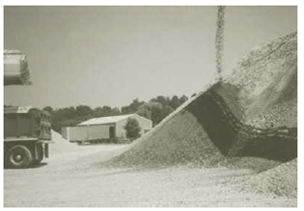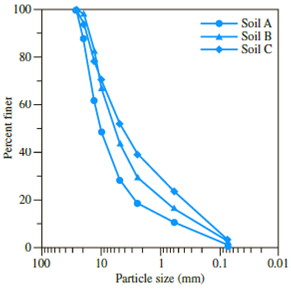![MindTap Engineering for Das/Sobhan's Principles of Geotechnical Engineering, 9th Edition, [Instant Access], 2 terms (12 months)](https://s3.amazonaws.com/compass-isbn-assets/textbook_empty_images/large_textbook_empty.svg)
Three groups of students from the

(a)

(b)
Figure 2.35 (a) Soil-aggregate stockpile; (b) sieve analysis (Courtesy of Khaled Sobhan, Florida Atlantic University, Boca Raton, Florida)
a. Determine the coefficient of uniformity and the coefficient of gradation for Soils A, B, and C.
b. Which one is coarser: Soil A or Soil C? Justify your answer.
c. Although the soils are obtained from the same stockpile, why are the curves so different? (Hint: Comment on particle segregation and representative field sampling.)
d. Determine the percentages of gravel, sand and fines according to Unified Soil Classification System.
(a)
Calculate the coefficient of uniformity
Answer to Problem 2.1CTP
The uniformity coefficient of soil A is
The coefficient of gradation of soil A is
The uniformity coefficient of soil B is
The coefficient of gradation of soil B is
The uniformity coefficient of soil C is
The coefficient of gradation of soil C is
Explanation of Solution
Sketch the grain size distribution curve for soils A, B, and C as shown in Figure 1.
![MindTap Engineering for Das/Sobhan's Principles of Geotechnical Engineering, 9th Edition, [Instant Access], 2 terms (12 months), Chapter 2, Problem 2.1CTP](https://content.bartleby.com/tbms-images/9781305970939/Chapter-2/images/70939-2-2.1ctp_image001.jpg)
Refer to Figure 1.
For soil A:
The diameter of the particle corresponding to
The diameter of the particle corresponding to
The diameter of the particle corresponding to
For soil B:
The diameter of the particle corresponding to
The diameter of the particle corresponding to
The diameter of the particle corresponding to
For soil C:
The diameter of the particle corresponding to
The diameter of the particle corresponding to
The diameter of the particle corresponding to
Calculate the uniformity coefficient
For soil A:
Substitute
Hence, the uniformity coefficient for soil A is
For soil B:
Substitute
Hence, the uniformity coefficient for soil B is
For soil C:
Substitute
Hence, the uniformity coefficient for soil C is
Calculate the coefficient of gradation
For soil A:
Substitute
Hence, the coefficient of gradation for soil A is
For soil B:
Substitute
Hence, the coefficient of gradation for soil B is
For soil C:
Substitute
Therefore, the coefficient of gradation for soil C is
(b)
State which of the soil is coarser from soil A and C.
Answer to Problem 2.1CTP
Soil A is coarser than soil C.
Explanation of Solution
Refer to part (a).
The uniformity coefficient of soil A is
The uniformity coefficient of soil C is
The percent of soil finer than
The percent of soil finer than
Hence, a higher percentage of soil C is finer than soil A.
Hence, soil A is coarser than soil C.
(c)
Explain the reason for curve different of soil A, B and C if it is obtained from same stockpile.
Explanation of Solution
The particle-size distribution curve shows the range of particle sizes present in a soil and the type of distribution of various-size particles.
Refer to Figure 1.
Particle separation of coarser and finer particles may take place in aggregate stockpiles. This makes representative sampling difficult.
Therefore, the particle-size distribution curve is different for soils A, B, and C.
(d)
Calculate the percentages of gravel, sand, and fines according to the Unified Soil Classification System.
Answer to Problem 2.1CTP
The percentage of gravel for soil A is
The percentage of sand for soil A is
The percentage of fines for soil A is
The percentage of gravel for soil B is
The percentage of sand for soil B is
The percentage of fines for soil B is
The percentage of gravel for soil C is
The percentage of sand for soil C is
The percentage of fines for soil C is
Explanation of Solution
Refer to Figure 1.
For soil A.
The percent passing through
The percent passing through
Calculate the percentage of gravel as shown below.
Hence, the percentage of gravel is
Calculate the percentage of sand as shown below.
Hence, the percentage of sand is
Calculate the percentage of fines as shown below.
Hence, the percentage of fines is
Refer to Figure 1.
For soil B.
The percent passing through
The percent passing through
Calculate the percentage of gravel as shown below.
Hence, the percentage of gravel is
Calculate the percentage of sand as shown below.
Hence, the percentage of sand is
Calculate the percentage of fines as shown below.
Hence, the percentage of fines is
Refer to Figure 1.
For soil C.
The percent passing through
The percent passing through
Calculate the percentage of gravel as shown below.
Hence, the percentage of gravel is
Calculate the percentage of sand as shown below.
Hence, the percentage of sand is
Calculate the percentage of fines as shown below.
Hence, the percentage of fines is
Want to see more full solutions like this?
Chapter 2 Solutions
MindTap Engineering for Das/Sobhan's Principles of Geotechnical Engineering, 9th Edition, [Instant Access], 2 terms (12 months)
- Explain the difference between a Class A and Class B bulkheadarrow_forwardBy using the yield line theory, determine the moment (m) for an isotropic reinforced concrete two-way slab shown in figure under a uniformly distributed load. Use segment Equilibrium method 2.5 A 7.0m c.g. ㄨˋ B 1 B A IA 2.5 2.0 + 2.5 5.0marrow_forwardGiven cross-classification data for the Jeffersonville Transportation Study Area in this table, develop the family of cross-classification curves. (Use high = $55,000; medium = $25,000; low = $15,000. Submit a file with a maximum size of 1 MB.) Choose File No file chosen This answer has not been graded yet. Determine the number of trips produced (by purpose) for a traffic zone containing 400 houses with an average household income of $35,000. 1610 HBW HBO Your response differs from the correct answer by more than 10%. Double check your calculations. trips 1791 NHB Your response differs from the correct answer by more than 10%. Double check your calculations. trips 1791 Your response differs from the correct answer by more than 10%. Double check your calculations. tripsarrow_forward
- 2.Water is siphoned from a reservoir. Determine (a) the maximum flow rate that can be achieved without cavitation occurring in the piping system (all indicated points) and (b) the maximum elevation of the highest point of the piping system to avoid cavitation. D = 20 cm, and d = 8 cm. The minimum pressure to avoid cavitation in the pipes is Pmin = 2340 Pa (absolute) for T = 20 °C. Water density = 1000 kg/m³. ✓ (1) T=20 C (4)arrow_forward3. Water flows steadily down the inclined pipe as shown. Determine (a) the difference in pressure pı-p2 and (b) the head loss between section (1) and section (2). Flow 5 ft Section (1) 6 in. 30°/ Section (2) 8 in. Mercuryarrow_forward1. Streams of water from two tanks impinges upon each other as shown. If viscous effects are negligible and point A is a stagnation point, determine the height h. Free ets Air 20 ft P₁ = 25 psi 8 ftarrow_forward
- Prob. Design the dimensions (rectangular) and longitudinal reinforcements for the beans sham. Design the beams as SRBS. Given: fi= 21 MPa fy= 275 hPa X= 23.5 kaf. λ= 1.0arrow_forwardPlease answer the following show me how to solve in your paper dont type thank youarrow_forwardProb. Design the dimensions (rectangular) and longitudinal reinforcements for the beans sham. Design the beams as SRBS. Given: fi= 21 MPa fy= 275 hPa X= 23.5 kaf. λ= 1.0arrow_forward
 Principles of Geotechnical Engineering (MindTap C...Civil EngineeringISBN:9781305970939Author:Braja M. Das, Khaled SobhanPublisher:Cengage Learning
Principles of Geotechnical Engineering (MindTap C...Civil EngineeringISBN:9781305970939Author:Braja M. Das, Khaled SobhanPublisher:Cengage Learning Traffic and Highway EngineeringCivil EngineeringISBN:9781305156241Author:Garber, Nicholas J.Publisher:Cengage Learning
Traffic and Highway EngineeringCivil EngineeringISBN:9781305156241Author:Garber, Nicholas J.Publisher:Cengage Learning Fundamentals of Geotechnical Engineering (MindTap...Civil EngineeringISBN:9781305635180Author:Braja M. Das, Nagaratnam SivakuganPublisher:Cengage Learning
Fundamentals of Geotechnical Engineering (MindTap...Civil EngineeringISBN:9781305635180Author:Braja M. Das, Nagaratnam SivakuganPublisher:Cengage Learning Construction Materials, Methods and Techniques (M...Civil EngineeringISBN:9781305086272Author:William P. Spence, Eva KultermannPublisher:Cengage Learning
Construction Materials, Methods and Techniques (M...Civil EngineeringISBN:9781305086272Author:William P. Spence, Eva KultermannPublisher:Cengage Learning Principles of Foundation Engineering (MindTap Cou...Civil EngineeringISBN:9781337705028Author:Braja M. Das, Nagaratnam SivakuganPublisher:Cengage Learning
Principles of Foundation Engineering (MindTap Cou...Civil EngineeringISBN:9781337705028Author:Braja M. Das, Nagaratnam SivakuganPublisher:Cengage Learning




